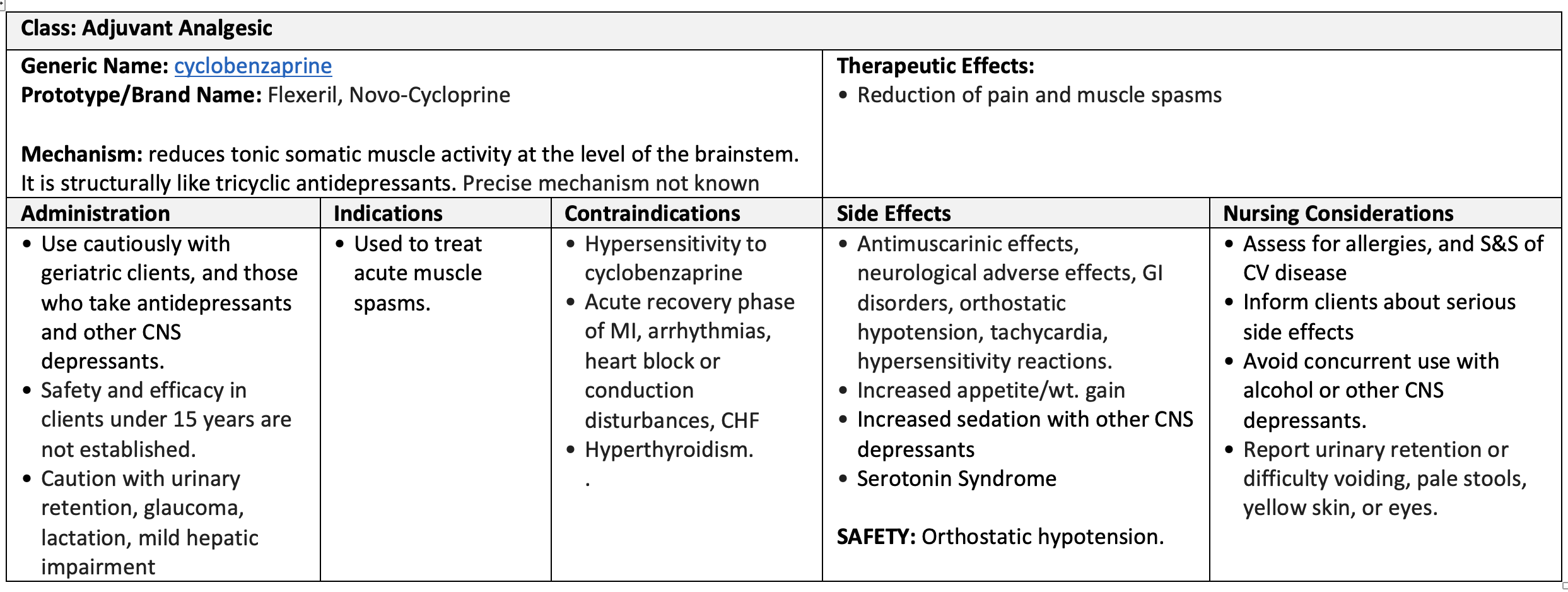Pain and Mobility
10.8 Adjuvant Analgesics
Open Resources for Nursing (Open RN)
Medications used as adjuvant analgesics were developed for other purposes but were later found to be effective to treat pain. Examples of adjuvant medications include gapapentin (an anticonvulsant) and amitriptyline (a tricyclic antidepressant). Additional information about these specific medications can be found in Chapter 8. Muscle relaxants are also considered an adjuvant analgesic and are used for various musculoskeletal disorders such as multiple sclerosis. Three different types of muscle relaxants will be discussed below baclofen, cyclobenzaprine, and tizanidine.
Baclofen
Mechanism of Action
Baclofen inhibits reflexes at the spinal level.
Indications for Use
Baclofen is used to treat muscle symptoms, such as spasms, pain, and stiffness, caused by multiple sclerosis, spinal cord injuries, or other spinal cord disorders.
Nursing Considerations Across the Lifespan
Baclofen is safe for clients 12 years and older.
Adverse/Side Effects
Adverse effects include drowsiness, dizziness or lightheadedness, confusion, nausea, constipation, and muscle weakness.
Abrupt Drug Withdrawal: Hallucinations and seizures have occurred on abrupt withdrawal of baclofen. Therefore, except for serious adverse reactions, the dose should be reduced slowly when the drug is discontinued.
Impaired Renal Function: Because baclofen is primarily excreted unchanged through the kidneys, it should be given with caution, and it may be necessary to reduce the dosage.
Signs and symptoms of overdose include vomiting, muscular hypotonia, drowsiness, accommodation disorders of the eye, coma, respiratory depression, and seizures.
Client Teaching & Education
The medication should be taken as directed and abrupt withdrawal of the medication should be avoided. It may cause dizziness or drowsiness. Clients should be advised to change positions slowly because of the potential orthostatic changes that may occur. Additionally, clients should avoid concurrent use with alcohol or other CNS depressants.
Now let’s take a closer look at the medication card for baclofen Table 10.8a[1]
Medication cards like this are intended to assist students to learn key points about each medication. Because information about medication is constantly changing, nurses should always consult evidence-based resources to review current recommendations before administering specific medication. Basic information related to each class of medication is outlined below. Prototype or generic medication examples are also hyperlinked to a free resource at Daily Med. On the home page, enter the drug name in the search bar to read more about the medication.
Table 10.7b Baclofen Medication Card.[2][3][4][5][/footnote]

Clinical Reasoning and Decision-Making Activity 10.8a
A client just started taking baclofen for muscle spasticity due to multiple sclerosis.
What teaching should the nurse provide?
Note: Answers to the Critical Thinking activities can be found in the “Answer Key” sections at the end of the book.
Cyclobenzaprine
Mechanism of Action
Cyclobenzaprine reduces tonic somatic muscle activity at the level of the brainstem. It is structurally similar to tricyclic antidepressants.
Indications for Use
Cyclobenzaprine is used to treat acute muscle spasms.
Nursing Considerations Across the Lifespan
Cyclobenzaprine is safe for clients 15 years and older. Use cautiously with geriatric clients. In the elderly, the frequency and severity of adverse events associated with the use of cyclobenzaprine, with or without concomitant medications, are increased. In elderly clients, cyclobenzaprine should be initiated with a 5 mg dose and titrated slowly upward.
Should not be used by breastfeeding women.
Adverse/Side Effects
Adverse effects include dizziness (may cause orthostatic hypotension) drowsiness, dry mouth, urinary retention, serotonin syndrome with antidepressant use, or increased sedation with other CNS depressants.
Because of its atropine-like action, cyclobenzaprine hydrochloride should be used with caution in clients with a history of urinary retention, angle-closure glaucoma, increased intraocular pressure, and in those taking anticholinergic medication.
Serotonin Syndrome
The development of a potentially life-threatening serotonin syndrome has been reported with cyclobenzaprine hydrochloride when used in combination with other drugs, such as selective serotonin reuptake inhibitors (SSRIs), serotonin-norepinephrine reuptake inhibitors (SNRIs), tricyclic antidepressants (TCAs), tramadol, bupropion, meperidine, verapamil, or MAO inhibitors (MAOIs). The concomitant use of cyclobenzaprine hydrochloride with MAO inhibitors is contraindicated.
Serotonin syndrome symptoms may include mental status changes (e.g., confusion, agitation, hallucinations), autonomic instability (e.g., diaphoresis, tachycardia, labile blood pressure, hyperthermia), neuromuscular abnormalities (e.g., tremor, ataxia, hyperreflexia, clonus, muscle rigidity), and/or gastrointestinal symptoms (e.g., nausea, vomiting, diarrhea). Treatment with cyclobenzaprine hydrochloride and any concomitant serotonergic agents should be discontinued immediately if the above reactions occur, and supportive symptomatic treatment should be initiated. If concomitant treatment with cyclobenzaprine hydrochloride and other serotonergic drugs is clinically warranted, careful observation is advised, particularly during treatment initiation or dose increases.
Impaired Hepatic Function
The plasma concentration of cyclobenzaprine is increased in clients with hepatic impairment. Cyclobenzaprine, especially when used with alcohol or other CNS depressants, may impair mental and/or physical abilities required for the performance of hazardous tasks, such as operating machinery or driving a motor vehicle.
Client Teaching & Education
The medication should be taken as directed and clients should be informed about what to be aware of related to serious side effects of the medication. Clients should be advised to change positions slowly because of the potential orthostatic changes that may occur. Additionally, clients should avoid concurrent use with alcohol or other CNS depressants. Clients should be aware that constipation may occur as a side effect of medication therapy and increased fluid intake may assist in preventing complications.
Now let’s take a closer look at the medication card for cyclobenzaprine Table 10.8b[6]
Table 10.7b Cyclobenzaprine Medication Card.[7][8][9][10][/footnote]

Clinical Reasoning and Decision-Making Activity 10.8b
A client asks if they can drive their car while taking cyclobenzaprine.
What is the nurse’s best response?
Note: Answers to the Critical Thinking activities can be found in the “Answer Key” sections at the end of the book.
Media Attributions
- baclofen
- cyclobenzaprine
- This work is a derivative of Daily Med by U.S. National Library of Medicine in the public domain. ↵
- RNPedia. (2021). https://www.rnpedia.com ↵
- DailyMed from US National Library of Medicine. www.dailymed.com ↵
- OpenMD.Com (2021). www.openmd.com ↵
- uCentral from Unbound Medicine. https://www.unboundmedicine.com/ucentral ↵
- This work is a derivative of Daily Med by U.S. National Library of Medicine in the public domain. ↵
- RNPedia. (2021). https://www.rnpedia.com ↵
- DailyMed from US National Library of Medicine. www.dailymed.com ↵
- OpenMD.Com (2021). www.openmd.com ↵
- uCentral from Unbound Medicine. https://www.unboundmedicine.com/ucentral ↵
Drugs with a primary indication other than pain that have analgesic properties in some painful conditions. The group includes numerous drugs in diverse classes such as gabapentin (an anticonvulsant) or amitriptyline (a tricyclic antidepressant).

